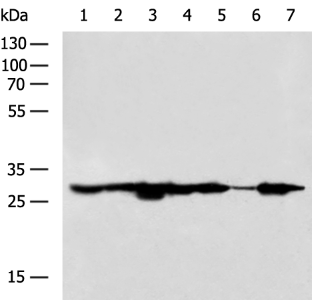| Cat.#: S217784 |
| Product Name: Anti-RPS3 Rabbit Polyclonal Antibody |
| Synonyms: S3; uS3 |
| UNIPROT ID: P23396 (Gene Accession – BC003137 ) |
| Background: Ribosomes, the organelles that catalyze protein synthesis, consist of a small 40S subunit and a large 60S subunit. Together these subunits are composed of 4 RNA species and approximately 80 structurally distinct proteins. This gene encodes a ribosomal protein that is a component of the 40S subunit, where it forms part of the domain where translation is initiated. The protein belongs to the S3P family of ribosomal proteins. Studies of the mouse and rat proteins have demonstrated that the protein has an extraribosomal role as an endonuclease involved in the repair of UV-induced DNA damage. The protein appears to be located in both the cytoplasm and nucleus but not in the nucleolus. Higher levels of expression of this gene in colon adenocarcinomas and adenomatous polyps compared to adjacent normal colonic mucosa have been observed. This gene is co-transcribed with the small nucleolar RNA genes U15A and U15B, which are located in its first and fifth introns, respectively. As is typical for genes encoding ribosomal proteins, there are multiple processed pseudogenes of this gene dispersed through the genome. Multiple alternatively spliced transcript variants encoding different isoforms have been found for this gene. |
| Immunogen: Fusion protein of human RPS3 |
| Applications: ELISA, WB, IHC |
| Recommended Dilutions: IHC: 25-100;WB: 1000-5000;ELISA: 5000-10000 |
| Host Species: Rabbit |
| Clonality: Rabbit Polyclonal |
| Isotype: Immunogen-specific rabbit IgG |
| Purification: Antigen affinity purification |
| Species Reactivity: Human, Mouse, Rat |
| Constituents: PBS (without Mg2+ and Ca2+), pH 7.4, 150 mM NaCl, 0.05% Sodium Azide and 40% glycerol |
| Research Areas: Epigenetics and Nuclear Signaling, Cancer |
| Storage & Shipping: Store at -20°C. Avoid repeated freezing and thawing |

Immunohistochemistry analysis of paraffin embedded Human breast cancer tissue using 217784(RPS3 Antibody) at a dilution of 1/25(Cytoplasm). | 
In comparision with the IHC on the left, the same paraffin-embedded Human breast cancer tissue is first treated with the fusion protein and then with 217784(Anti-RPS3 Antibody) at dilution 1/25. | 
The image on the left is immunohistochemistry of paraffin-embedded Human thyroid cancer tissue using 217784(Anti-RPS3 Antibody) at a dilution of 1/25. | 
In comparision with the IHC on the left, the same paraffin-embedded Human thyroid cancer tissue is first treated with fusion protein and then with D223063(Anti-RPS3 Antibody) at dilution 1/25. | 
Gel: 8%SDS-PAGE, Lysate: 40 μg;
Lane 1-7: HepG2, Jurkat, Hela, Raji, RAW264.7, A549, 293T cell lysates;
Primary antibody: 217784(RPS3 Antibody) at dilution 1/800;
Secondary antibody: HRP-conjugated Goat anti rabbit IgG at 1/5000 dilution;
Exposure time: 6 seconds | |
|















